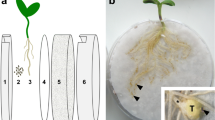Abstract
Experimental interruption of the root stele of Pisum sativum L. induces in the cortex tissue the development of wound-sieve tubes which bridge the wound and reconnect the vascular stumps. Outside the stele, sieve plates arise from primary pit fields. This origin is confirmed by the distribution of future sieve pores over the original parenchyma cell wall and by remnants of the pitfield cavity in developing sieve plates. Differentiation of wound-sieve elements is similar to that of bundle-sieve elements and includes the chromatolytic disintegration of nuclei as well as the development of typical sieve pores arising from pit-field plasmodesmata. The completion of first woundsieve tubes (indicated by a continuous chain of anilin-blue-positive sieve plates by-passing the wound) was observed 55–62 h after wounding. However, effective translocation, visualized with fluoresceine as a phloem-mobile marker, was not found until 10 h (on average) later. It is suggested that this time delay corresponds to the maturing of the last link within a chain of wound-sieve-tube members. Presumably, enucleate sieve elements with widened pores are a prerequisite for effective phloem translocation.
Similar content being viewed by others

Abbreviations
- DAPI:
-
4′,6-diamidino-2-phenylindole·2 H2O
- ER:
-
endoplasmic reticulum
References
Behnke, H.-D., Schulz, A. (1980) Fine structure, pattern of division, and course of wound phloem in Coleus blumei. Planta 150, 357–365
Behnke, H.-D., Schulz, A. (1983) The development of specific sieve-element plastids in wound phloem of Coleus blumei (S-type) and Pisum sativum (P-type), regenerated from amyloplast-containing parenchyma cells. Protoplasma 114, 125–132
Eleftheriou, E.P., Tsekos, I. (1982) Development of protophloem in roots of Aegilops comosa var. Thessalica. II. Sieve-element differentiation. Protoplasma 113, 221–233
Esau, K., Gill, R.H. (1972) Nucleus and endoplasmic reticulum in differentiating root protophloem of Nicotiana tabacum. J. Ultrastruct. Res. 41, 160–175
Esau, K., Gill, R.H. (1973) Correlations in differentiation of protophloem sieve elements of Allium cepa root. J. Ultrastruct. Res. 44, 310–328
Esau, K., Thorsch, J. (1984) The sieve plate of Echium (Boraginaceae): Develoopmental aspects and response of P-protein to protein digestion. J. Ultrastruct. Res. 86, 31–45
Esau, K., Thorsch, J. (1985) Steve plate pores and plasmodesmata, the communication channels of the symplast: Ultrastructural aspects and developmental relations. Am. J. Bot. 72, 1641–1653
Eschrich, W. (1953) Beiträge zur Kenntnis der Wundsiebröhren-Entwicklung bei Impatients holsti. Planta 43, 37–74
Gersani, M., Lips, S.H., Sachs, T. (1980) Effects of wounding on transport in phloem. J. Exp. Bot. 31, 783–789
Karnovski, M.J. (1965) A formaldehyde-glutaraldehyde fixative of high osmolality for use in electron microscopy. J. Cell Biol. 27, 137A-138A
Sachs, T. (1975) The induction of transport channels by auxin. Planta 127, 201–206
Sachs, T., Cohen, D. (1982) Circular vessels and the control of vascular differentiation in plants. Differentiation 21, 22–26
Schulz, A. (1986a) Wound phloem in transition to bundle phloem in primary roots of Pisum sativum L. I. Development of bundle-leaving wound-sieve tubes. Protoplasma 130, 12–26
Schulz, A. (1986b) Wound phloem in transition to bundle phloem in primary roots of Pisum sativum L. II. The plasmatic contact between wound-sieve tubes and regular phloem. Protoplasma 130, 27–40
Schulz, A. (1986c) The beginning of translocation in wound phloem. In: Phloem transport, pp. 183–185, Cronshaw, J., Lucas, W.J., Giaquinta, R.T. eds. Alan R. Liss Inc. New York
Schumacher, W. (1933) Untersuchungen über die Wanderung des Fluoreszeins in den Siebröhren. Jb. Wiss. Bot. 77, 685–732
Thorsch, J., Esau, K. (1981) Ultrastructural studies of protophloem sieve elements in Gossypium hirsutum. J. Ultrastruct. Res. 75, 339–351
Author information
Authors and Affiliations
Rights and permissions
About this article
Cite this article
Schulz, A. Sieve-element differentiation and fluoresceine translocation in wound-phloem of pea roots after complete severance of the stele. Planta 170, 289–299 (1987). https://doi.org/10.1007/BF00395019
Received:
Accepted:
Issue Date:
DOI: https://doi.org/10.1007/BF00395019



